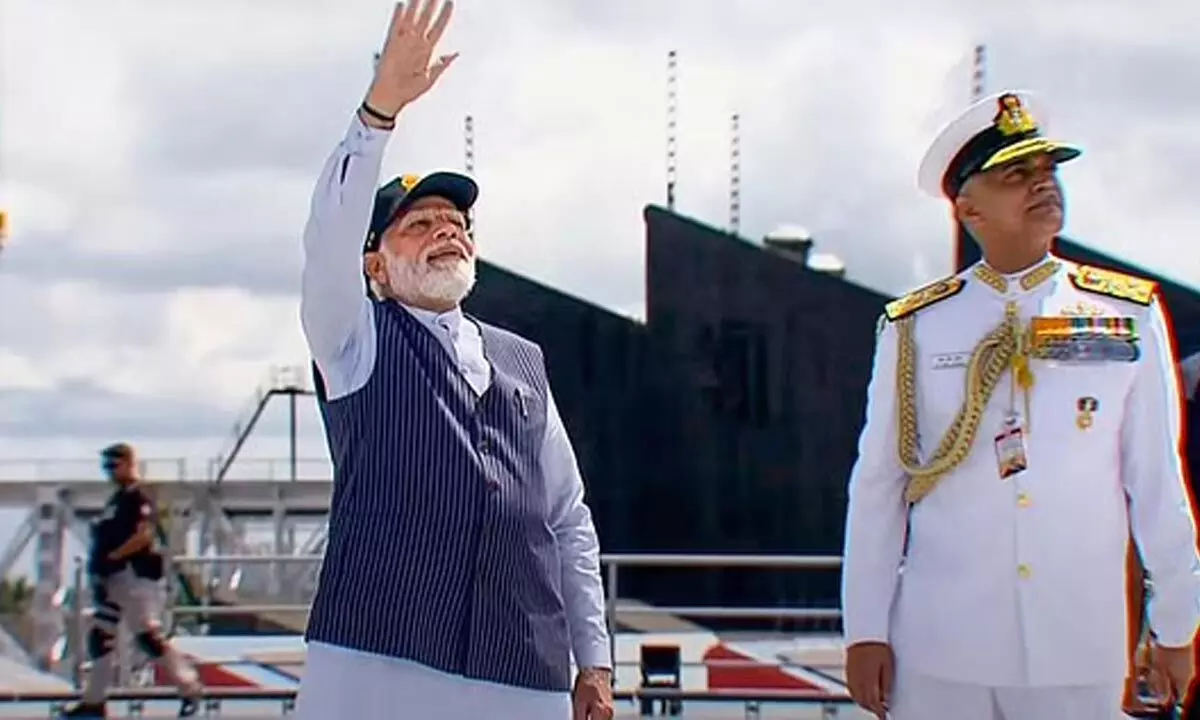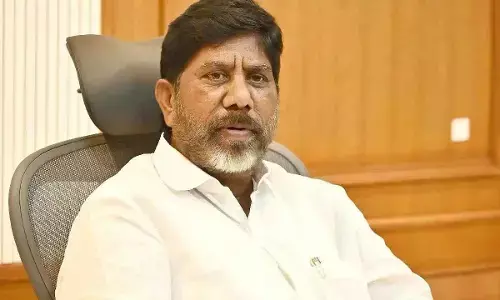PM Modi commissions India's first indigenous aircraft carrier INS Vikrant

Prime Minister Narendra Modi with Chief of Naval Staff Admiral R. Hari Kumar during the commissioning ceremony of INS Vikrant (Photo | PTI)
Prime Minister Narendra Modi on Friday morning commissioned the first indigenous aircraft carrier, INS Vikrant in a ceremony at Cochin Shipyard Limited in Kochi.
KOCHI: Prime Minister Narendra Modi on Friday morning commissioned the first indigenous aircraft carrier, INS Vikrant in a ceremony at Cochin Shipyard Limited in Kochi.
Ahead of the commissioning, PM Modi received the Guard of Honour at the Shipyard received a Guard of Honour as he arrived for the Commissioning ceremony.
Designed by the Indian Navy's in-house Warship Design Bureau (WDB) and built by Cochin Shipyard Limited, a Public Sector Shipyard under the Ministry of Ports, Shipping and Waterways, Vikrant has been built with state-of-the-art automation features and is the largest ship ever built in the maritime history of India.
The Indigenous Aircraft Carrier is named after her illustrious predecessor, India's first aircraft carrier, which had played a vital role in the 1971 war.
It has a large amount of indigenous equipment and machinery, involving major industrial houses in the country as well as over 100 MSMEs. With the commissioning of Vikrant, India will have two operational aircraft carriers, which will bolster the maritime security of the nation.
As per the Indian Navy, the 262-meter-long carrier has a full displacement of close to 45,000 tonnes which is much larger and more advanced than her predecessor.
Speaking about the specifications of IAC Vikrant, Vice Admiral Hampiholi had said: "Vikrant carries a mix of about 30 aircraft. It could fly the MiG 29k fighter aircraft in anti-air, anti-surface and land attack roles. It will be able to operate the Kamov 31 which is an early air warning helicopter, the recently inducted but yet-to-be commissioned MH-60R which is a multi-role helicopter as also our very indigenous ALH. It displaces about 45,000 tonnes which is definitely the largest warship in the Indian naval inventory."
With Vikrant, India has joined a select group of nations having the niche capability to indigenously design and build an aircraft carrier.IAC Vikrant consist of 14 decks with 2,300 compartments which can carry around 1,500 sea warriors and to cater to the food requirements, around 10,000 chapatis or rotis are made in the ship's kitchen, which is called the ship's galley.
The ship is powered by four Gas Turbines totalling 88 MW power and has a maximum speed of 28 Knots. Built at an overall cost of close to Rs 20,000 crores, the project has been progressed in three Phases of the contract between MoD and CSL, concluded in May 2007, December 2014 and October 2019 respectively.
The ship's keel was laid in Feb 2009, followed by launching in August 2013.
With an overall indigenous content of 76 per cent, IAC is a perfect example of the nation's quest for "Aatma Nirbhar Bharat" and provides a thrust to Government's 'Make in India' initiative.
Vikrant has been built with a high degree of automation for machinery operation, ship navigation and survivability, and has been designed to accommodate an assortment of fixed-wing and rotary aircraft.
The ship would be capable of operating an air wing consisting of 30 aircraft comprising of MIG-29K fighter jets, Kamov-31, MH-60R multi-role helicopters, in addition to indigenously manufactured Advanced Light Helicopters (ALH) and Light Combat Aircraft (LCA) (Navy). Using a novel aircraft-operation mode known as STOBAR (Short Take-Off but Arrested Landing), the IAC is equipped with a ski- jump for launching aircraft, and a set of 'arrester wires' for their recovery onboard.
The ship has a large number of indigenous equipment and machinery, involving major industrial houses in the country viz. BEL, BHEL, GRSE, Keltron, Kirloskar, Larsen & Toubro, Wartsila India etc. as well as over 100 MSMEs.The indigenisation efforts have also led to the development of ancillary industries, besides the generation of employment opportunities and bolstering plough back effect on the economy, both locally as well as pan-India.
A major spin-off of this is the development and production of indigenous warship-grade steel for the ship through a partnership between the Navy, DRDO and Steel Authority of India (SAIL), which has enabled the country to become self-sufficient with respect to warship steel. Today all the warships being built in the country are being manufactured using indigenous steel, added the Navy.
Several design iterations, including the use of 3D Virtual Reality models and advanced engineering software, were used by the Directorate of Naval Design in shaping the design of the carrier. CSL had also upgraded their shipbuilding infrastructure as well as enhanced productivity skills during the building of the ship.














